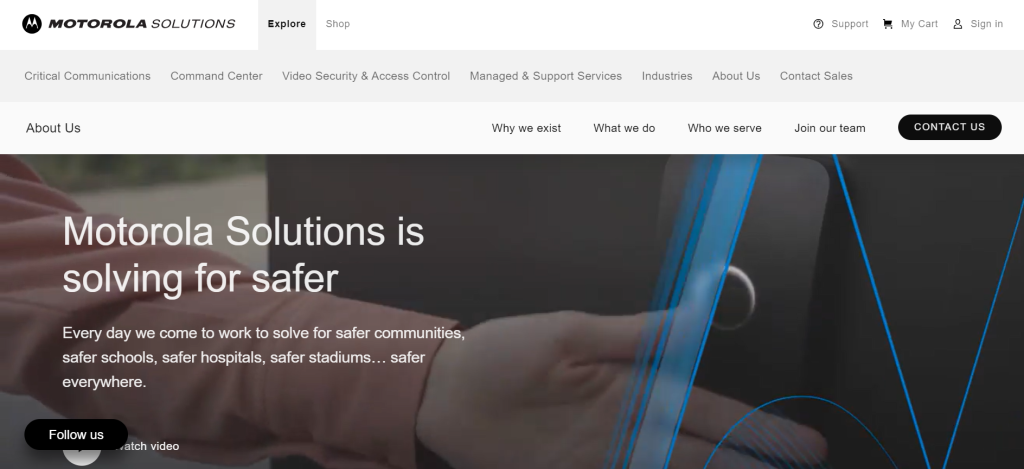Table of Contents
ToggleA Brief History of Motorola Solutions
Motorola Solutions, Inc. is a leading communications and technology company that was established in 1928 as the Galvin Manufacturing Corporation by brothers Paul and Joseph Galvin. The company initially focused on producing battery eliminators, which allowed battery-powered radios to operate on household electricity.
In 1930, the company introduced the brand name “Motorola” for its car radios, combining “motor” (for motorcar) with “ola” (which implied sound). This brand quickly gained prominence and became associated with innovation and quality in the field of communications.
Throughout the 20th century, Motorola continued to expand its product line, becoming a leader in the development of two-way radios and communication devices for commercial and government use. The company also played a pioneering role in the development of mobile phones, launching the first commercially available handheld mobile phone in 1983.
In 2011, Motorola, Inc. split into two separate companies – Motorola Mobility and Motorola Solutions. Motorola Solutions focuses on providing communication products and services for public safety, government, and commercial customers. The company continued to innovate and expand its offerings, providing a wide range of communication solutions, including radio systems, body-worn cameras, and software applications.
Today, Motorola Solutions, Inc. is a global leader in mission-critical communication and technology solutions, serving customers in over 100 countries. The company is committed to providing reliable and innovative products that enable public safety organizations and businesses to communicate and collaborate effectively.
Who Owns Motorola Solutions?
Motorola Solutions, Inc. is owned by a number of institutional and individual investors. The top 10 shareholders as of the latest available information include The Vanguard Group, Inc., BlackRock, Inc., T. Rowe Price Associates, Inc., ClearBridge Investments, LLC, State Street Corporation, Fidelity Management & Research Company, Capital Research & Management Company, Bank of America Corporation, Goldman Sachs & Co. LLC, and Morgan Stanley & Co. LLC. These shareholders hold significant stakes in the company and have a say in its overall direction and performance.
Motorola Solutions Mission Statement

Motorola Solutions, Inc. is committed to providing innovative communication and technology solutions that enable public safety and commercial organizations to effectively respond to and manage critical situations. Their mission is to help customers stay connected and safe by delivering reliable and secure communication networks, advanced devices, and integrated software. They strive to be a trusted partner in creating safer communities and more efficient businesses through their dedication to quality, integrity, and excellence.
How Motorola Solutions Makes Money?
Motorola Solutions, Inc. operates in the communications and technology industry, providing communications equipment, software, and services to a wide range of customers including public safety agencies, government entities, and commercial enterprises. The company’s business model revolves around generating revenue through the sale of its products and services, including two-way radios, video surveillance systems, and software solutions for public safety and enterprise communications. Motorola Solutions also generates recurring revenue through maintenance services, software upgrades, and ongoing support contracts for its customers. Additionally, the company offers a range of managed and support services, further diversifying its revenue streams. Overall, Motorola Solutions’ business model is focused on providing essential communication solutions to various industries and generating revenue through a combination of product sales, services, and support contracts.
Motorola Solutions Business Model Canvas
The Business Model Canvas is a strategic management tool that provides a visual representation of a company’s business model. It outlines the key components of a business, including its value proposition, customer segments, revenue streams, and more. In this business model canvas for Motorola Solutions, Inc., we will explore how the company creates, delivers, and captures value in the communication and technology industry.
Customer Segments:
1. Government agencies: Motorola Solutions provides communication solutions to various government agencies, including law enforcement, fire departments, and emergency services.
2. Enterprise customers: The company serves businesses and organizations with their communication and technology needs.
3. Public safety organizations: Motorola Solutions offers products and services to support public safety and emergency response.
Value Propositions:
1. Reliable communication solutions: Motorola Solutions offers secure and reliable communication technology for mission-critical operations.
2. Innovative technology: The company provides cutting-edge technology solutions to meet the evolving needs of its customers.
3. End-to-end services: Motorola Solutions offers comprehensive services, from consultation and design to implementation and support.
Channels:
1. Direct sales: Motorola Solutions sells its products and services directly to customers through its sales team.
2. Channel partners: The company also leverages channel partners to distribute its products and reach a broader customer base.
3. Online presence: Motorola Solutions utilizes its website and online platforms for sales and customer engagement.
Customer Relationships:
1. Personalized support: The company provides personalized support and ongoing maintenance to its customers.
2. Training and education: Motorola Solutions offers training programs and educational resources to help customers maximize their technology investments.
3. Community engagement: The company fosters a community of users and industry professionals to facilitate collaboration and knowledge sharing.
Revenue Streams:
1. Product sales: Motorola Solutions generates revenue from the sale of its communication devices and solutions.
2. Service contracts: The company offers maintenance and support contracts to customers, generating recurring revenue.
3. Software licensing: Motorola Solutions obtains revenue from the licensing of its proprietary software solutions.
Key Resources
1. Technology infrastructure: The company’s investment in technology infrastructure enables the development and delivery of innovative products and services.
2. Skilled workforce: Motorola Solutions relies on its talented workforce to drive innovation and deliver exceptional customer experiences.
3. Intellectual property: The company’s patents and proprietary technology are critical resources for maintaining a competitive edge.
Key Activities:
1. Research and development: Motorola Solutions invests in R&D to continually innovate and develop new products and solutions.
2. Sales and marketing: The company engages in sales and marketing activities to promote and sell its products and services.
3. Customer support: Motorola Solutions provides ongoing support and maintenance to ensure customer satisfaction.
Key Partners:
1. Suppliers: The company relies on suppliers to provide the components and materials necessary for its products.
2. Channel partners: Motorola Solutions collaborates with channel partners to distribute its products and reach a broader customer base.
3. Technology partners: The company works with technology partners to integrate and enhance its offerings with complementary solutions.
Cost Structure:
1. Research and development: The investment in R&D is a significant cost for Motorola Solutions as it continually develops new and innovative products.
2. Production and manufacturing: The company incurs costs related to the production and manufacturing of its communication devices and solutions.
3. Sales and marketing: Motorola Solutions allocates resources to sales and marketing activities to promote its offerings and acquire new customers.
Motorola Solutions’s Competitors
Motorola Solutions, Inc. faces stiff competition in the technology and communications industry. Some of its top competitors include:
1. Cisco Systems
2. Harris Corporation
3. Nokia
4. Hytera Communications Corporation
5. Zebra Technologies
Motorola Solutions SWOT Analysis
Strengths:
1. Strong brand recognition and reputation in the telecommunications industry
2. Diverse portfolio of products and solutions for public safety, government, and commercial customers
3. Robust research and development capabilities for innovative technology solutions
4. Global presence and strong market position in critical communications and mission-critical applications
Weaknesses:
1. Dependence on government contracts, making the company vulnerable to changes in the political landscape
2. Limited presence in consumer markets compared to competitors
3. Reliance on a few key suppliers for critical components in their products
4. Vulnerability to cybersecurity threats due to the nature of their business
Opportunities:
1. Growth potential in emerging markets for critical communications and public safety solutions
2. Expansion of product offering into adjacent markets such as smart cities, transportation, and healthcare
3. Increasing demand for advanced technology in public safety and surveillance
Threats:
1. Intense competition from established players and new entrants in the telecommunications industry
2. Regulatory changes and government budget constraints impacting demand for their products
3. Rapid technological advancements leading to the obsolescence of existing products
4. Economic downturns affecting government spending on critical communications and public safety.
Concluding Analysis
In summary, the business model of Motorola Solutions, Inc. is focused on providing innovative communication solutions for public safety and commercial customers. With a strong emphasis on research and development, the company continues to launch new products and services that cater to the evolving needs of its clients. As an analyst, I am optimistic about the future of Motorola Solutions, Inc. The company’s strategic approach to technology and its commitment to meeting the demands of the market position it for continued success. I believe that its strong track record in the industry and ongoing investment in cutting-edge solutions will allow Motorola Solutions, Inc. to remain a key player in the telecommunications and public safety sectors for years to come.
Additional Resources
To keep learning and advancing your career, we highly recommend these additional resources:
Business Model Canvas of The Top 1,000 Largest Companies by Market Cap in 2024
A List of 1000 Venture Capital Firms & Investors with LinkedIn Profiles
Peter Thiel and the 16 Unicorns: The Legacy of Thiel Fellowship












